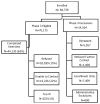Respiratory disease in United States farmers
- PMID: 24913223
- PMCID: PMC4542002
- DOI: 10.1136/oemed-2013-101983
Respiratory disease in United States farmers
Abstract
Objectives: Farmers may be at increased risk for adverse respiratory outcomes compared with the general population due to their regular exposures to dusts, animals and chemicals. However, early life farm exposures to microbial agents may result in reduced risk. Understanding respiratory disease risk among farmers and identifying differences between farmers and other populations may lead to better understanding of the contribution of environmental exposures to respiratory disease risk in the general population.
Methods: We compared the prevalence of self-reported respiratory outcomes in 43548 participants from the Agricultural Health Study (AHS), a prospective cohort of farmers and their spouses from Iowa and North Carolina, with data from adult participants in the National Health and Nutrition Examination Survey (NHANES) over the same period (2005-2010).
Results: AHS participants had lower prevalences of respiratory diseases (asthma, adult-onset asthma, chronic bronchitis and emphysema), but higher prevalences of current respiratory symptoms (wheeze, cough and phlegm) even after controlling for smoking, body mass index and population characteristics. The overall prevalence of asthma in the AHS (7.2%, 95% CI 6.9 to 7.4) was 52% of that in NHANES (13.8%, 95% CI 13.3 to 14.3), although the prevalence of adult-onset asthma among men did not differ (3.6% for AHS, 3.7% for NHANES). Conversely, many respiratory symptoms were more common in the AHS than NHANES, particularly among men.
Conclusions: These findings suggest that farmers and their spouses have lower risk for adult-onset respiratory diseases compared with the general population, and potentially higher respiratory irritation as evidenced by increased respiratory symptoms.
Published by the BMJ Publishing Group Limited. For permission to use (where not already granted under a licence) please go to http://group.bmj.com/group/rights-licensing/permissions.
Figures


Similar articles
-
Prevalence of chronic respiratory symptoms among Ohio cash grain farmers.Am J Ind Med. 1999 Feb;35(2):150-63. doi: 10.1002/(sici)1097-0274(199902)35:2<150::aid-ajim7>3.0.co;2-5. Am J Ind Med. 1999. PMID: 9894539
-
Diesel exhaust, solvents, and other occupational exposures as risk factors for wheeze among farmers.Am J Respir Crit Care Med. 2004 Jun 15;169(12):1308-13. doi: 10.1164/rccm.200309-1228OC. Epub 2004 Apr 7. Am J Respir Crit Care Med. 2004. PMID: 15070818
-
Prevalence of asthma and respiratory symptoms in dairy farmers in the French province of the Doubs.Am J Respir Crit Care Med. 1998 Nov;158(5 Pt 1):1493-8. doi: 10.1164/ajrccm.158.5.9709108. Am J Respir Crit Care Med. 1998. PMID: 9817698
-
Respiratory illness in agricultural workers.Occup Med (Lond). 2002 Dec;52(8):451-9. doi: 10.1093/occmed/52.8.451. Occup Med (Lond). 2002. PMID: 12488515 Review.
-
Health effects of cotton dust exposures.Am J Ind Med. 1990;17(1):39-45. doi: 10.1002/ajim.4700170108. Am J Ind Med. 1990. PMID: 2407115 Review.
Cited by
-
Occupational agriculture organic dust exposure and its relationship to asthma and airway inflammation in adults.J Asthma. 2016 Jun;53(5):471-7. doi: 10.3109/02770903.2015.1116089. Epub 2016 Jan 19. J Asthma. 2016. PMID: 26785925 Free PMC article. Review.
-
Indoor Airborne Microbial Concentration and Dry Eye.Am J Ophthalmol. 2021 Mar;223:193-204. doi: 10.1016/j.ajo.2020.10.003. Epub 2020 Oct 14. Am J Ophthalmol. 2021. PMID: 33065065 Free PMC article.
-
Methacholine induced airway contraction in porcine precision cut lung slices from indoor and outdoor reared pigs.Am J Transl Res. 2020 Jun 15;12(6):2805-2813. eCollection 2020. Am J Transl Res. 2020. PMID: 32655811 Free PMC article.
-
Investing in prospective cohorts for etiologic study of occupational exposures.Am J Ind Med. 2015 Feb;58(2):113-22. doi: 10.1002/ajim.22403. Am J Ind Med. 2015. PMID: 25603935 Free PMC article.
-
Profiling of cell stress proteins reveals decreased expression of enzymatic antioxidants in tracheal epithelial tissue of pigs raised indoors.Am J Transl Res. 2019 Sep 15;11(9):5716-5727. eCollection 2019. Am J Transl Res. 2019. PMID: 31632542 Free PMC article.
References
-
- Schenker MB, Christiani D, Cormier Y, et al. Respiratory health hazards in agriculture. Am J Respir Crit Care Med. 1998;158:S1–S76. - PubMed
-
- Leynaert B, Neukirch C, Jarvis D, et al. Does living on a farm during childhood protect against asthma, allergic rhinitis, and atopy in adulthood? Am J Respir Crit Care Med. 2001;164:1829–34. - PubMed
-
- Douwes J, Travier N, Huang K, et al. Lifelong farm exposure may strongly reduce the risk of asthma in adults. Allergy. 2007;62:1158–65. - PubMed
-
- Blair A, Malker H, Cantor KP, et al. Cancer among farmers. A review. Scand J Work Environ Health. 1985;11:397–407. - PubMed
-
- Omland O. Exposure and respiratory health in farming in temperate zones—a review of the literature. Ann Agric Environ Med. 2002;9:119–36. - PubMed
Publication types
MeSH terms
Substances
Grants and funding
LinkOut - more resources
Full Text Sources
Other Literature Sources
Medical
